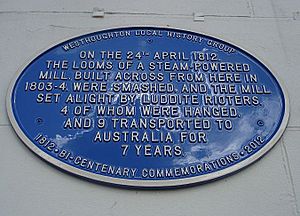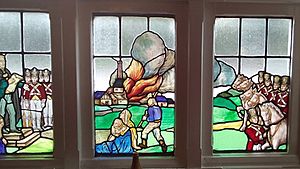Westhoughton Mill facts for kids
Westhoughton Mill, also known as Rowe and Dunscough's Mill, was a cotton mill located on Mill Street in Westhoughton, near Bolton in the historic county of Lancashire. It became famous for a major attack by a group called the Luddites in 1812. The mill was first built in 1804 by Richard Johnson Lockett. He later leased it to Thomas Rowe in 1808.
Contents
Why Were People Upset?
During 1811 and 1812, many people in England were struggling. New machines were being used in factories, especially in the textile industry. These machines could do the work much faster and cheaper than skilled workers, like weavers, who used to work from their homes. This meant that many people lost their jobs and their way of making a living.
These upset workers joined a group known as the Luddites. They believed that the only way to get their jobs back and improve their lives was to destroy the new machines. The government tried to stop them by passing strict laws. For example, in February 1812, the Frame Breaking Act made damaging powered looms a crime punishable by death. Despite these harsh laws, Luddite protests and attacks on mills grew, especially around Manchester.
The Attack on Westhoughton Mill
On Friday, April 28, 1812, a large group of weavers and mechanics gathered in Westhoughton. Their goal was to destroy the power looms inside Rowe and Dunscough's Mill. The government had sent soldiers, called the Scots Greys, to Bolton to help keep order. They were called to Westhoughton, but when they arrived, everything seemed calm, so they went back to their base.
However, soon after the soldiers left, the mill and everything inside it were set on fire. By the time the military returned, the building was destroyed, and the people responsible had disappeared. Later that evening, some of the rioters gathered in the village, demanding food, drinks, or money. The soldiers were called back again, and the Riot Act was read, which was a warning for people to disperse or face serious consequences.
Information was collected about the leaders of the attack. Twenty-four men were arrested and sent to Lancaster Assizes for trial. Some were released, but four men—Job Fletcher, James Smith, Thomas Kerfoot, and Abraham Charlson—were found guilty of "wilfully and maliciously set[ting] on fire and burnt[ing] a Weaving Mill." They faced the death penalty and were executed. Nine other men were sent to a distant land as punishment. After this Luddite attack, many factory owners avoided building new mills in Westhoughton for a long time.
What Happened to the Mill After?
After the attack, Westhoughton Mill was rebuilt. It was first used as a corn mill, which grinds grain. Then, in 1840, a cotton manufacturer named Peter Ditchfield bought it. He turned it back into a cotton mill. When he passed away in 1854, the mill, which by then employed about 40 people, was taken over by his son, Peter Ditchfield Junior.
The mill continued to spin cotton and make flock (a material used for stuffing) for many years. Eventually, production stopped, and the mill became empty. It was finally torn down in 1912. The site where the mill once stood is still an empty plot of land today.
See also
- List of mills in Bolton



